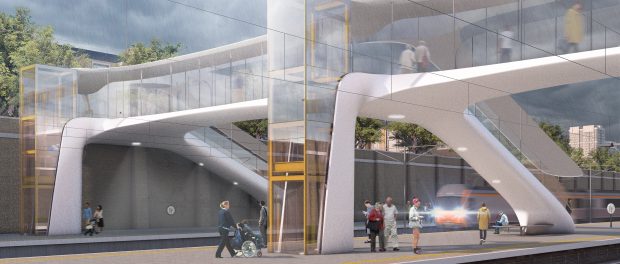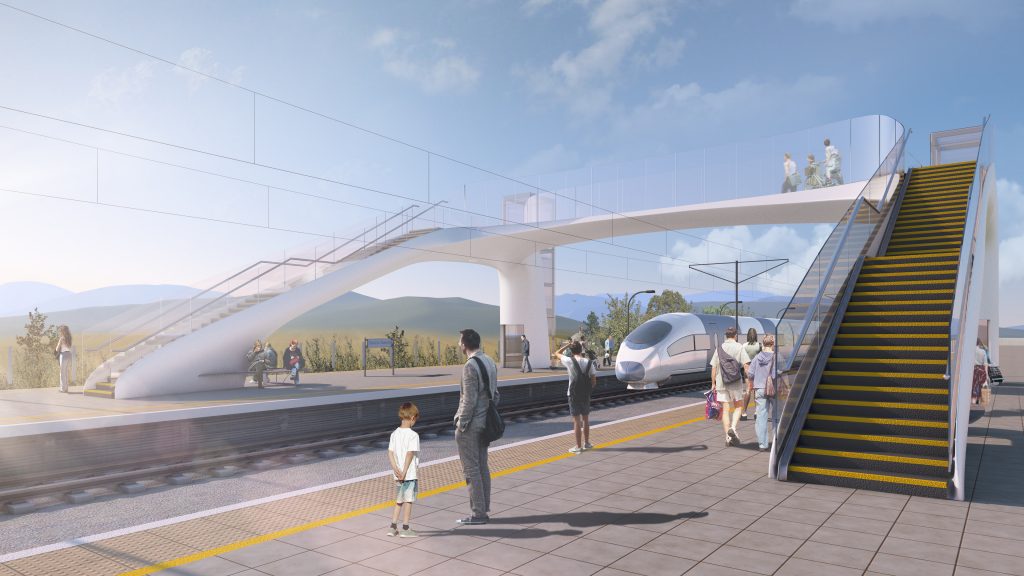NCC partner with Network Rail

The NCC (National Composites Centre) has partnered with Network Rail to investigate, design and build a composite footbridge.
The new partnership sees Network Rail join the NCC as a Tier One Member – the first rail infrastructure company to do so – which gives Network Rail access to use the world-leading expertise facilities and capabilities at the Centre.
The concept footbridge, conceived and designed by Marks Barfield Architects & COWI and called “Futura”, is being developed into a prototype to demonstrate the benefits that can be gained from using composites in railway station environments for both new build and replacement structures.
“We’re delighted to be working on this ground-breaking project with Network Rail, and that they have joined us as a Member. There is clear alignment between the long-term strategic goals of the two organisations – namely to accelerate the adoption of composites in construction and to support the UK’s supply chain development to achieve the Government’s Construction 2025 strategy,” said Richard Oldfield, Chief Executive of the NCC.
“Composites offer huge benefits to construction, not least in their ability to be built using modern methods, as well as the cost-effective nature of their construction and installation. They are a more sustainable solution, which will contribute to net-zero targets across the industry, and are an intrinsically safer and more aesthetically pleasing option.”
Ian Grimes, principal engineer from Network Rail added: “Our main focus is on putting our passengers first and exploring the full potential of composites as an alternative low carbon construction material will enable us to continue doing this.
“The quicker installation and the corrosion resistant nature of composites will mean less disruption and impact on passengers when we’re installing and maintaining our assets.
“This offers further environmental benefits alongside cost savings which can then be reinvested into other parts of the network.”
The footbridge demonstrator will adopt modern methods of construction and platform architecture through a standardised design and set of adaptable components created in factories with digital controls for simple, rapid precision fit assembly in the station environment. It will also enable innovation that can be transferred to the wider transport infrastructure and nurture the supply-chain, so it is “not held back by historical norms” as identified in the Transport Infrastructure Efficiency strategy set out by the Government. The project will specifically target key metrics of reduced cost and reduced greenhouse gas emission in line with Construction 2025.
“High strength modern composite materials present huge opportunities for a new generation of bridges and structures,” commented Ian Firth, engineering designer with COWI, “and we are delighted to be working with Marks Barfield, NCC and Network Rail to bring this elegant design to life on the railways. This is a material we have used before in bridge design, but I am particularly excited about the opportunity to optimise its use on this project to achieve the very best performance advantages that the material allows.”
“After two years in the making MBA are delighted to be kicking off this exciting project with COWI and the team at the NCC for Network Rail. Our aim from the inception of the project has been to bring the benefits of large scale pre-fabrication using cutting edge innovation through the use of composite materials, whilst at the same time delivering on Peter Hendy’s aim of delivering high quality design to the rail sector,” added Ian Crockford, Project Director at Marks Barfield Architects.

